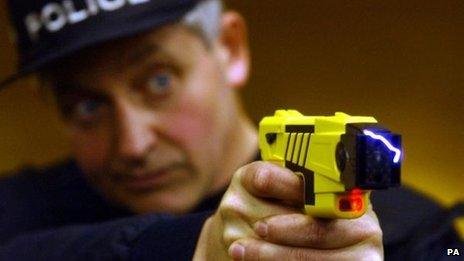Police Taser use more than doubles - Home Office
- Published

The police use of Tasers is growing, but Acpo has issued new guidance on their use
Police use of Tasers in England and Wales more than doubled between 2009 and 2011, according to Home Office figures., external
The devices were used 7,877 times in 2011, compared with 3,328 in 2009.
In only about a quarter (25.7% in 2011) were they actually discharged. In most situations they were only readied or pointed as a warning.
The Independent Police Complaints Commission is probing 12 Taser-related incidents, three involving deaths.

Tasers were first trialled in 2004 and their use has since been rolled out to all forces in England and Wales. Officers are required to take a training course before being allowed to use a Taser and they are told only to deploy them when threatened with violence.
Human rights group Amnesty International said it was "concerned" about the figures and called for only a small number of officers to be allowed to use the weapons.
"The increasing rollout of Tasers across the UK is a grave concern. Amnesty International is worried about every bobby on the beat having a Taser on their belt - it's not a modern truncheon," said the group's UK director Kate Allen.
"A Taser doesn't just give a little tingle - it's a potentially lethal 50,000-volt weapon and should not be spoken of as some sort of 'natural progression' of the standard policing kit."
'Public concern'
Her concerns were echoed by the Independent Police Complaints Commission, which expressed particular worry about the use of Tasers in direct contact with someone's body.
The commission said that it had received 68 complaints about Taser use by police in 2010, a figure which rose to 101 in 2011 but fell slightly to 98 last year.
IPCC deputy chair Deborah Glass said: "The IPCC recognises that there is public concern over the considerable increase in Taser use, not only in the number of officers using it but also in circumstances where it would not have been used previously - and a rise in complaints that has accompanied that.
"We do have concerns about some of the ways and circumstances in which the Taser is used, bearing in mind that each use must be justified as being necessary and proportionate to the perceived threat.
"The IPCC is currently independently investigating 12 cases and supervising police investigations into a further seven cases involving the use of Taser."
But the Association of Chief Police Officers pointed out that the percentage of occasions when the Taser was fired had not increased over the years.
Spokesman Simon Chesterman said he believed this was evidence of the "extensive and consistent training" which police had implemented.
"Officers are trained to use Taser to deal with violence or threats of violence and they are individually accountable in law for the amount of force they use," he said.
And president of the Police Superintendents' Association of England and Wales, Irene Curtis, said using Tasers could mean fewer officers and members of the public were hurt.
"It is not a surprise that the number of deployments has increased because the number of people with access to Tasers has increased in that time," she said.
"We support the rollout of Tasers. We think it's a really useful tool that officers can use and can help reduce injuries to the public and to police officers.
"A Taser used appropriately can reduce the amount of time that officers need to have off because it reduces injuries. It reduces harm to the public because if there's a dangerous individual, they can be restrained more quickly.
"And sometimes the only other option is firearms. A Taser isn't a gun. A Taser can in some circumstances cause less harm than striking someone with a baton."
Red-dotted
The Home Office figures showed that the total deployment of Tasers increased each year from 3,128 in 2009, to 6,649 in 2010 and 7,877 in 2011.
It further broke down its figures to show what percentage of the deployments involved the weapon being "discharged" and "not discharged".
Incidents where a Taser was used but "not discharged" include when the weapon was drawn and aimed; when it was "arced" - which means sparking it without having a target; and when it was "red-dotted" - which means using the targeting mechanism without firing.
Most of those cases when a Taser was "discharged" involved the Taser being fired - where the probes are shot towards the target still attached to the weapon by copper wiring. It can also be used to "drive stun" - where it is held against the target's body.
The percentage figures provided by the Home Office suggest that discharges increased from around 850 in 2009, to around 1,650 in 2010 and around 2,050 in 2011.
The use of "drive-stunning" grew by one percentage point to 5% of all uses from 2010 to 2011.
Acpo has recently issued new guidance discouraging the use of Tasers at point-blank range. It believes the use of the weapon in "drive-stun" mode often serves only to antagonise the victim further.
- Published10 September 2013
- Published31 August 2013
- Published22 August 2013
- Published27 April 2013